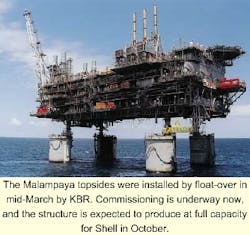ASIA/PACIFIC: Commissioning underway on Philippines' Malampaya platform
The largest integrated deck in the Asia/Pacific region was installed on the Malampaya field offshore The Philippines in mid-March in preparation for onstream operations this summer. Kellogg Brown & Root (Halliburton) installed the facility on a concrete base as a complete integrated deck slightly ahead of schedule.
At an installation weight of 11,500 tons, the Malampaya topsides is the largest integrated deck ever installed in the region and currently the largest offshore installation in the world using the floatover method. This method, pioneered by KBR, allows an integrated deck to be installed as one unit, maximizing fabrication and testing work that can be completed onshore. KBR engineered, fabricated, and installed the gas processing facility for Shell Philippines Exploration B.V. KBR reported that the Shell Philippines Managing Director said he was struck by the "silent elegance" of the docking and mating of the two structures.
Tow-out to site
The topsides set sail from its fabrication site in Singapore on 1 March 2001 and arrived at the site 50 km northwest of Palawan Island, a distance of 1,134 nautical miles, on March 10. The average speed of the tow was five knots. The tow was performed by three ocean going tugs with a combined power of 39,000 bhp, generating a bollard pull up to 300 tons. Sea states experienced during the tow were generally calm with swells of up to two meters.
The Malampaya topsides were transported on a newly constructed barge, the H-541 owned by Heerema Marine Contractors Nederland B.V. who held a subcontract from Kellogg Brown & Root to transport and install the topsides. The H-541 is 165 meters long, 42 meters wide, and maintained a draft of 5.7 meters during the tow. The topsides were supported 22 meters above the deck of the barge on a transportation truss weighing 1,500 tons. The truss, together with the barge freeboard enabled the legs of the topsides to pass over the tops of the concrete gravity substructure (CGS) shafts during the initial installation phase.
Installation
The H-541 barge and its three tow tugs rendezvoused with the Rockwater 2, a maneuvering tug, and another ocean-going tug at the location off Palawan Island. The Rockwater 2 is capable of dynamic position-holding without using anchors and acted as the construction support vessel during the installation period.
During the initial two days after arrival of the installation spread, final preparations for the topsides installation were made on the CGS and H-541 barge. Shortly afterwater, a second maneuv- ering tug joined the installation spread, and all eight vessels and equipment waited for sea states to reduce so that installation could commence.
By 16 March 2001, swells were down to 0.5 meters, and the forecast for the next 72 hours was good. One tow and one docking tug began maneuvering the H-541 barge. Two pre-laid anchors and four docking lines attached to the CGS shafts were connected to winches on the H-541 barge.Then, the H-541 was maneuvered between the legs of the CGS.
By the next day, the H-541 barge was connected to the first of the 4-in. diameter steel wire mating lines, and ballasting operations commenced with 36 pumps combining to transfer seawater at more than 21,000 tons per hour into the H-541.
Later that day, first contact was made between the CGS leg mating units and the deck leg supports of the topside facility. Rubber columns in the deck legs and on the transportation frame allowed a progressive transfer of weight to the CGS. Fifty seven minutes later, the topsides weight had been fully transferred to the CGS, and nine hours later, the H-541 barge was clear of the platform.
Sand jacks on each of the four CGS leg mating units were then simultaneously released allowing the topside to be lowered in a controlled manner into its final position. The contact points are now being welded together to form the one permanent structure of the Malampaya platform.
Offshore commissioning
Kellogg Brown & Root is using the Rockwater 2 as its construction support vessel during the offshore commissioning phase now underway. The target is to complete commissioning such that the platform can export treated gas, through a 504 km pipeline to shore, by August 1, 2001.
This will allow the onshore gas plant at Batangas on Luzon Island, the Philippines, to begin on schedule. Following onshore gas plant commissioning, the Malampaya platform will be ready to supply gas to power plants in the Philippines by October 1, 2001.
The Malampaya platform topsides measures 40 meters by 92 meters. The topside consists of three decks: weather, production, and cellar decks. They contain the equipment necessary to separate produced water and condensate from the wet gas stream flowing from the wellheads. The integrated offshore processing facility is located in 43-meter water depths, with subsea wells located in 850 meters water depth.
Construction of the topside facility commenced on May 27, 1999 in Singapore and took 21 months to complete. In the summer of 2000, KBR installed the concrete base for the platform at the offshore location, three months ahead of schedule.
During the transportation of the topsides, the flare tip was 105 meters above sea level. This height required KBR to notify air traffic control of the departure of the topsides from Singapore.
The topsides feature dry low emission gas generators, a world first for the RB211 units installed offshore. Another feature is 100% spared flash gas compression to minimize flaring. Waste heat is recovered from the export gas compressors to conserve energy. The flare system is purged with nitrogen to avoid continuous flaring.

